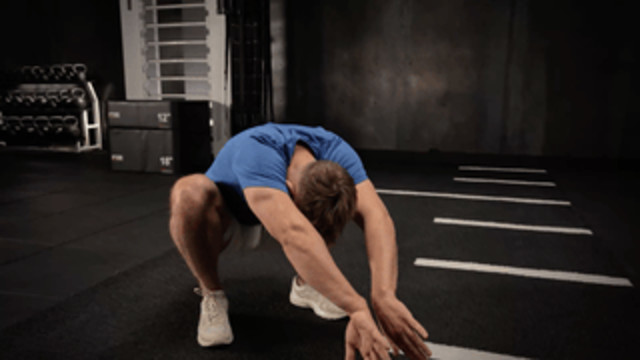Use Animal Flow to build mobility, strength, and skill with just your body weight.
There’s a common misconception that you need to have access to equipment — dumbbells, barbells, TRX straps, the works — in order to treat your body to a truly challenging workout. But really, all you need is your body and some open floor space. Case in point: Animal Flow.
Created by Mike Fitch, Animal Flow is a hybrid of multiple disciplines that all involve ground-based movement patterns, including calisthenics, yoga, martial arts, and breakdancing (specifically Breakletics). Many of the exercises are rooted in animal locomotion, reflected in the three foundational positions — ape, beast, and crab — that most of the flows begin with. Through controlled, fluid movement, you build functional strength, mobility, balance, and coordination.
The heart of Animal Flow is the switches and transitions. Just like yoga, the dynamic movements seamlessly shift from one to the next; you might start in a loaded beast and transition into a front step-through. They can each be linked together to create countless combinations, so every practice can be slightly different from the last. But you can also perform each movement independently, particularly the foundational exercises, and train them as stand-alone skills.
No matter how you bake the exercises into your routine, Animal Flow helps mobilize and strengthen your joints, allowing you to be both fluid and limber. That’s why I like to use Animal Flow as a 15-minute warm-up before practicing calisthenics skills, as it primes my joints and muscles for the handstands, muscle ups, and front levers ahead. The exercises are closed-chain, meaning the distal segments of the body (say, the feet or hands) are fixed. During loaded beast, for example, your toes are glued to the ground. These types of movements place compressive forces on the joints, so over time, they can also enhance joint stability — and that can reduce the risk of injury.
RELATED: Train Your Toes to Live Longer

What’s more, the fundamental moves of Animal Flow are multi-planar — they challenge your body in all planes of motion. Traditional strength training is largely one-dimensional; a bench press is simply moving weight from point A to point B in one straight line. When you’re regularly working with the transverse plane (think: rotational movements), frontal plane (think: side-to-side movements), and sagittal plane (think: forward and backward moves), you’re strengthening the entire joint in all angles. You’re taking your joints through their full ranges of motion, training them to become stronger in those movement patterns. The payoff? When you need to jump sideways to avoid a patch of ice or rogue scooter driver, for instance, your joints can handle that sudden change in direction and are less likely to get injured.
Working in three dimensions also requires your entire body to coordinate and work together to complete a task. Sure, isolating certain muscle groups is good for aesthetics and correcting muscle imbalances in some cases, but it’s important to treat the body as one unit. If you want to be functionally fit and strong, you need to train your lower body, upper body, and core simultaneously, using your mobility and physical and mental coordination to get the job done. (Plus, when you perform these flows at medium to high intensities and incorporate traveling forms, you get a cardio workout, too.)
RELATED: Forged at Equinox: Jack and Jeric

As a skill-based practice, Animal Flow does require some baseline levels of strength, mobility, and coordination to get started; without them, it’s usually a bit more challenging to be successful with the method — and enjoy it. Still, once you have those foundations down, Animal Flow is accessible to all fitness levels. To progress, you do have to put in the work; you’ll really need to build up your mobility to accomplish more advanced movements. That said, this is where — in my opinion — the most exciting movements of Animal Flow come in, so it’s worth the dedication.
There are plenty of online resources to help you on your journey, but I believe the best way to learn is to hire a Coach. Having a second set of eyes watching you, making sure you have the proper mechanics and you’re activating the correct muscle groups for each movement, can help you succeed much quicker than if you were to practice on your own.

As you’re exploring, avoid progressing your practice too quickly. I often see people performing a movement or skill that’s too advanced for what they’re able to effectively accomplish at that moment, like hand-balancing techniques. Those types of moves require a solid foundation in order to perform safely and successfully. Think of it this way: You wouldn’t try doing a butterfly stroke when it’s your very first time in a pool, right? You’d start with something simple, like learning how to breathe in the water. With Animal Flow, begin with the basics and level up only when you feel 100 percent confident and comfortable.
Regardless, remember that it’s okay to make mistakes as you test out Animal Flow moves and sequences. I promise, you’ll only learn and grow from them.
Jeric Rosales is a Coach+ at Equinox Plano. Jeric has worked at Equinox since 2023 and is an ACE-certified personal trainer and level 1 certified Animal Flow instructor. He has practiced Animal Flow since 2020, leads an Animal Flow small group at Equinox, and also practices and teaches calisthenics and boxing.
